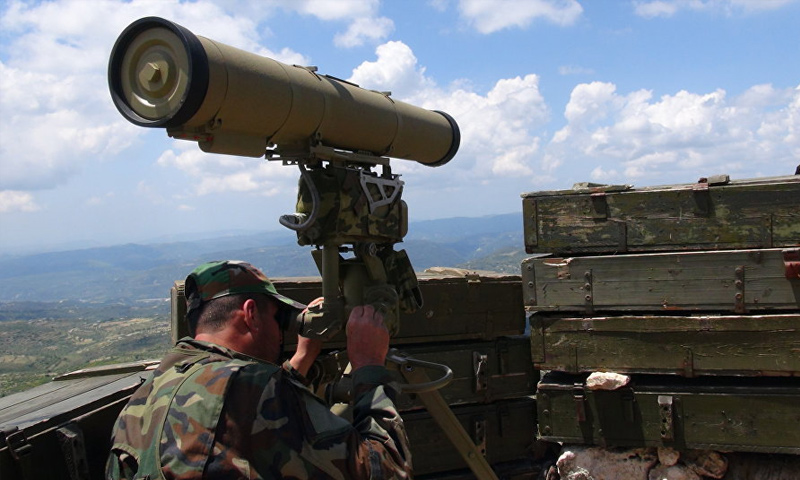



With the Israeli-Iranian military escalation in Syria, the talks’ focus was turned onto the air defense regiments which Israel has been concentrating its attacks on; similarly, Assad’s forces’ interest has grown in these regiments in Southern Syria, being the first line to defend the southern front of the capital Damascus.
Several air defense regiments and battalions spread in the area from the city of al-Kiswah, rural Damascus, towards the south, distributed on the governorates Daraa, Quneitra and As-Suwayda.
Despite the wide geographical control of the opposition factions in Southern Syria, Assad’s forces are yet in control of many air defense positions, including “Battalion110” near the city of al-Sanamayn, the “Battalion613” close to the town of Nahtah and the “Battalion 60” in the vicinity of the al-Sihailiah town.
In addition to the battalions defending the Khalkhalah military air base in the As-Suwayda governorate; however, a single name has went viral in media for the past a few weeks, which is the air defense “Jabab Regiment” that is accused for downing the Israeli military aircraft last February.
In southern Damascus, 40 km from the west of the cease fire line in the occupied Golan, the aerial defense “Regiment 189” is located, as a part Assad’s forces formations; it is called “Regiment 89,” as a shorter name, or the “Jabab Regiment,” being adjacent to the town of Jabab in rural Daraa. The Regiment is based on a number of military points, positioned between the two towns of Jabab and Muthabin. The number of its members is over 150.
The opposition factions do not have accurate information about the Regiment’s inclusion of Iranian elements, but the Iranian militias control of the two building of the Yarmouk and Qasioun universities, based a few kilometers away from the place where the Regiment is based, encourages the hypothesis of the Regiment’s supervision by Iranian consultants.
When the Syrian revolution broke out, just like the rest of the military formations under Assad’s forces, the “Jabab Regimen’s” weaponry was supplemented with mortars, artillery guns and short-range rocket launchers, which have been used in the shelling of the towns and cities surrounding the area, particularly the towns in Lajat area, as Mohammad al-Balili, a Lieutenant who dissented from the same regiment, has informed Enab Baladi.
It was also provided with batteries for medium-range missiles that are prepared to carry the cluster munitions containers which were regularly used in the bombardment of Daraa al-Balad during the “Death rather than Humiliation Battle” and during the military campaign that Assad’s forces launched against Eastern Ghouta in rural Damascus.
After the reinforcement of the Iranian presence in Southern Syria, Iran exploited the strategic location of the “Jabab Regiment” and relocated it as an air defense fulcrum to protect the Iranian bases, in Damascus and its surrounding, from Israeli air raids. The batteries of the air defense system “S200,” Russian made, were rehabilitated. It is also likely that the Regiment is supplied with the most up to date air defense systems, but the enhancement of the fortifications within Tell al-Nebbe Osha, the prophet Joshua, helped Assad’s forces hide these systems.
According to the dissident lieutenant, the “Jabab Regiment” participated in the confrontations between Assad’s forces and the Israeli forces; actually, it played a leading role in the response operations, if compared to the neighboring air defense battalions.
The Regiment launched a major amount of the missiles it possessed when other battalions responded only by massively relying on the traditional “23 machine guns”, which explains why the Regiment was targeted to larger extent by the Israeli strikes, the last of which was on the 10th of May, when Israel hit the regiment with two missiles that set the place ablaze and killed and injured a number of Assad’s forces personal, who were transported to the hospitals in al-Sanamayn and Damascus, according to the information that Enab Baladi received from military sources back then.
On the other side, the opposition factions in the different parts of Syria were satisfied with watching the confrontations, despite some of the appeals launched by activists who called on the opposition factions to utilize the Israeli attacks to progress towards the targeted positions. Nonetheless, the situation on the ground was not that simple, for the Israeli attacks concentrated on the air defense systems and accurately chosen sites, which are not positioned at the major defense lines between Assad’s forces and the opposition.
The majority of the targeted sites are relatively far from the confrontation lines, in addition to the fact that the opposition factions were basically not ready to indulge in wide range battles in Southern Syria after they were handicapped by the “de-escalation” agreement since July 2017.
The military map has placed the “Jabab Regiment” out of the opposition’s calculations, although controlling it means having control over the international highway, which obliges the opposition factions to first seize the “Brigade134-Tnks” in the area of al-Masmiyah and all the military brigades surrounding it in the east of the Highway, in addition to controlling the city of al-Sanamayn and the adjacent “9th Division” located in the west of the highway, these are the undertakings that opposition should consider first of all, which it, at the same time, does not seem to be ready to address.
if you think the article contain wrong information or you have additional details Send Correction